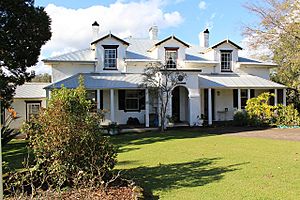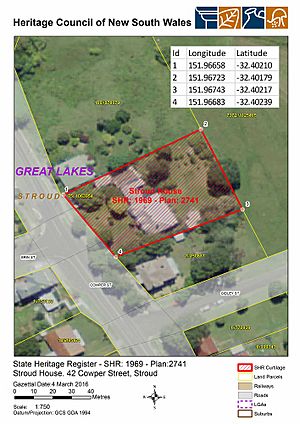Stroud House (Stroud, New South Wales) facts for kids
Quick facts for kids Stroud House |
|
|---|---|
 |
|
| Location | 42 Cowper Street, Stroud, Mid-Coast Council, New South Wales, Australia |
| Built | 1827–1839 |
| Architect | Thomas Laman |
| Owner | Private ownership |
| Official name: Stroud House | |
| Type | state heritage (built) |
| Designated | 4 March 2016 |
| Reference no. | 1969 |
| Type | House |
| Category | Residential buildings (private) |
| Builders | AACo convict labour force |
| Lua error in Module:Location_map at line 420: attempt to index field 'wikibase' (a nil value). | |
Stroud House is a very old and important home located at 42 Cowper Street in Stroud, Australia. It was built between 1827 and 1839. This historic house is listed on the New South Wales State Heritage Register, which means it's officially recognized as a special place worth protecting. It was added to this list on March 4, 2016.
The Story of Stroud House
Why Stroud House Was Built
After the Napoleonic Wars (1799-1815), Britain needed more wool for its textile factories. They used to get wool from places like Germany. But they wanted their own supply to make more money. Australia, with its huge open lands and many workers, seemed like the perfect place to raise sheep.
In 1824, a big company called the Australian Agricultural Company (AACo) was created. It was the first large farming company in Australia. The British Parliament gave the AACo a lot of money and a huge piece of land. Their main job was to raise fine wool sheep. They also bred cattle and horses and grew crops.
Starting the AACo in Australia
Robert Dawson, a farmer from Wales, was chosen to manage the AACo. He arrived in Australia in 1825 with workers and animals. Dawson explored the land north of the Hunter Valley. He found Port Stephens, which had deep water for ships.
Dawson thought the area was perfect for farming. He saw fresh rivers, rich soil, and rolling hills. He believed it would be great for the company's goals. So, the AACo decided to set up its main base there. They chose a million acres of land between Port Stephens and the Manning River.
Building Carrington and Stroud
In early 1826, Dawson led the first group of AACo staff to Port Stephens. They started building the company's headquarters and first town at Carrington. The AACo aimed to be a self-sufficient community. They used the skills of their staff, workers, and even local Aboriginal people to build everything quickly.
After Carrington was set up, Dawson explored more of the land. In late 1826, he picked Stroud as the site for the company's main farm and second town. Work began right away. By 1827, people said Stroud was excellent for all kinds of farming.
Challenges and Changes
However, the AACo faced problems. Decisions made in Britain took a long time to reach Australia. Also, Dawson's choice of land wasn't perfect. The coastal area was too humid and the soil wasn't great for sheep. Port Stephens wasn't good for big ships, and Carrington often flooded.
These problems led to disagreements between Dawson and the company leaders. Dawson left the company and returned to Britain in 1828.
To fix things, Captain Edward Parry arrived in 1829. He was an explorer and navigator. Parry decided to live in Stroud during the sheep shearing and harvest seasons. To make a suitable home for his family, an existing AACo cottage (built in 1827) was greatly improved. By 1832, this renovated and expanded cottage became Stroud House.
Parry worked hard to find better land for the company. He helped the AACo start making a profit. But then, the wool trade in London faced problems in 1836, and Britain had a financial crisis.
Stroud House Through the Years
Stroud grew a lot in the 1830s, with many new buildings and more people. In 1839, Captain Phillip Parker King, another explorer and navigator, became the new AACo manager. He added the front porch to Stroud House, giving it the look it mostly has today. The house hasn't changed much since then.
As the Australian economy slowed down in the 1840s, the AACo changed its plans. They started selling land to make money. Stroud remained a small town. The AACo eventually moved its main focus to cattle farming further north. Even after many challenges, the Australian Agricultural Company is still in business today, making it one of Australia's oldest companies.
Stroud House continued to be an important building. It was used as a bank and then a doctor's office. Today, it's a private home again. Interestingly, it's now owned by the family of Admiral Phillip Parker King, who added the front porch back in 1839. The family bought the house in 2003.
The house was officially listed on the NSW State Heritage Register in April 2016.
What Stroud House Looks Like
Stroud House started as a simple one-story cottage in 1827. It was then greatly expanded in 1832. It's now a two-story building with extra rooms for servants. The house is made of brick, covered in a smooth finish, and painted. It has a metal roof, though some of the original slate tiles are still on the servant's quarters.
The house has porches at the front and back. There's a special entrance area called a portico at the front. You can see three dormer windows on the front of the roof. There are also three brick chimneys, matching the old fireplaces inside. The servant's quarters have two chimneys.
Inside, Stroud House has two main reception rooms and several bedrooms and living areas. Many of the original red cedar wood details are still there, like the skirting boards and door frames. The only major change inside since 1890 was the removal of part of one wall. This was likely done when the house was used as a bank.
How Well Preserved is Stroud House?
Considering how old it is, Stroud House is in good condition. The ground under the house has shifted a bit over time. This has caused some slight changes in the floor levels inside. But the house was built very strongly and has handled these changes well.
Stroud House is very well preserved. It still has its original layout, with only one wall partially removed. This happened when it was used as the Bank of Australasia. Many original features are still there. These include red cedar wood, floorboards, fireplaces, and plaster ceilings. Some old servant bell systems can even still be seen.
Changes Made Over Time
- 1827: The first single-story cottage was built by the AACo.
- 1833: Captain Sir Edward Parry had the cottage renovated and made bigger for his family.
- 1839: Admiral Phillip Parker King added the front portico to the house.
- 1890: Some changes were likely made when it became the Bank of Australasia.
- 1931: It was probably changed a bit to be used as a doctor's office.
- 1945: Likely changed back to a private home.
- 2004-2014: The roof was replaced, electrical systems updated, and general repairs were done.
- 2011: Drainage work was done, and some porch timbers damaged by termites were replaced.
Why Stroud House is Important
Stroud House is very important because of its strong connection to the Australian Agricultural Company (AACo). This company was the first large-scale farming business in Australia. It brought a lot of money into the colony.
Stroud was the AACo's second town and a big farm, started in 1827. Stroud House was built for the company's managers and important visitors. Because it dates back to the very beginning of the company, Stroud House is a key reminder of the AACo's early days and how they developed the Port Stephens area.
Stroud House is also important because it was built by workers who were convicts. It's a rare and well-preserved early colonial building. By studying Stroud House, we can learn more about how important people lived in early New South Wales. We can also learn about the building skills of the AACo's convict workforce.
Because it's so well preserved, Stroud House is a great example of early colonial architecture. It shows how buildings were made during an important time in the history of farming and development in New South Wales.
Stroud House was added to the New South Wales State Heritage Register on March 4, 2016, because it met several important criteria.
Connecting to History
Stroud House shows us the history of New South Wales because of its links to the Australian Agricultural Company. This company was a huge part of Australia's early farming history. Stroud House was built by the company's convict workers. It reflects an important time when New South Wales was developing its farming regions.
Important People and Groups
Stroud House is important because of its connection to the Australian Agricultural Company and its convict workforce. The house was built under the guidance of Thomas Laman, a former convict. He also oversaw the building of other important structures for the AACo, like St Johns Anglican Church in Stroud.
Beautiful and Skillful Design
Unlike some other AACo buildings, Stroud House is large and fancy. It shows the high status of the AACo managers and guests who lived there. It started as a small cottage but was greatly improved in 1832 by convict workers. Its good condition makes it one of the best examples of colonial architecture in New South Wales today.
Learning from the Past
Stroud House can teach us a lot about how important colonists lived in New South Wales. Because it's so well preserved, it shows the living standards and styles of the AACo's leaders in the early 1800s. The way Stroud House was built also gives us information about the building methods and skills of the convict workforce during Australia's colonial expansion.
A Special Example of History
While old colonial buildings exist in New South Wales, Stroud House is special because it's so well preserved. It dates from 1827 and was changed to its current form in 1832. It still has much of its original layout and materials, including bricks and wood made by convicts.
Stroud House is a great example of early colonial architecture in New South Wales. It shows the domestic life and tastes of important British colonists. It's also a fine example of a house built by convicts during the 1830s colonial period. Its excellent condition makes it one of the best examples of colonial architecture in New South Wales today.



